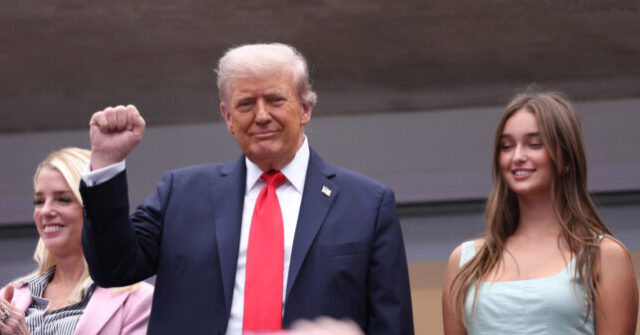The U.S. economy is projected to grow at a faster pace over the next three years thanks to recent tax cuts and spending measures by the Republican majorities on Capitol Hill and signed into law by President Donald Trump, the Congressional Budget Office said Friday.
The nonpartisan agency now expects the economy to be larger through 2028 than it projected in January, with real gross domestic product ending the forecast period 0.1 percent higher than previously estimated. The upward revision reflects the net positive impact of three major policy changes: the 2025 reconciliation act, new tariffs on roughly 75 percent of imported goods, and reduced immigration levels.
GDP growth is projected to reach 2.2 percent in 2026, up from the 1.8 percent the CBO forecast in January, driven primarily by the sweeping tax legislation known as the One Big Beautiful Act that was championed by President Donald Trump and passed by Congress on a party-line vote. The law permanently extended individual income tax cuts and allowed businesses to immediately expense equipment, research and development costs. The agency expects these measures to strengthen consumer spending and encourage private investment while federal spending on defense and immigration enforcement adds further stimulus.
“The reconciliation act’s effects boosting growth dominate the effects slowing it that stem from the reduction in net immigration” in 2026, the CBO said in its report. The report refers to the recent tax law as the reconciliation act.
The improved 2026 outlook follows a projected slowdown to 1.4 percent growth in 2025, down from an earlier estimate of 1.9 percent, as tariffs temporarily dampen consumer spending and business investment. The agency expects inflation to rise to 3.1 percent this year before falling to 2.4 percent in 2026 and reaching the Federal Reserve’s two percent target by 2027.
Unemployment is forecast to peak at 4.5 percent in the fourth quarter of 2025, then improve to 4.2 percent in 2026 as the tax law’s incentives for work and investment take effect. The jobless rate is expected to level off at 4.4 percent in 2027 and 2028.
The law’s provisions are expected to boost employment, income, and business investment while increasing the economy’s underlying productive capacity.
Lower effective tax rates on labor income and work requirements for certain government benefit recipients are projected to expand the labor supply, while full expensing of business investments should increase the capital stock.
The CBO said that in its view higher tariffs implemented by the Trump administration will reduce economic efficiency by shifting resources to less productive domestic industries and raising costs for businesses that rely on imported inputs. However, these negative effects are more than offset by the law’s stimulus to aggregate demand and long-term productive capacity.
Not all analysts agree that tariffs will reduce economic efficiency. By offsetting economic distortions created by foreign industrial and trade policy, U.S. tariffs could improve global and domestic efficiency, these analysts say. If that’s correct, the boost to growth is likely to be even greater than the CBO estimates.
Between January and August, the administration implemented new tariffs on imported goods representing about 75 percent of total U.S. imports by value. The CBO expects these tariffs to raise prices for consumer goods and services, eroding household purchasing power in the near term.
Trade flows are expected to contract in 2025, with imports falling 3.7 percent and exports declining 5.0 percent as businesses adjust to higher tariff levels. The agency projects trade policy uncertainty, which peaked in April, will continue to delay some investments through 2027 before dissipating.
In 2027 and 2028, GDP growth is projected to moderate to 1.8 percent annually as the reconciliation act’s near-term demand boost fades and slower labor force growth from reduced immigration acts as a drag. Even so, economic activity is expected to remain above levels that would have prevailed without the policy changes.
Interest rates are forecast to decline gradually, with the federal funds rate falling from 4.0 percent this year to 3.3 percent by 2027 as the Federal Reserve responds to softer economic conditions and moderating inflation pressures.
The economic projections assume current policies remain in place through the forecast period and incorporate administrative actions affecting immigration through September 2025. The CBO cautioned that the projections are highly uncertain and could be affected by future legislative or administrative changes.
Read the full article here


